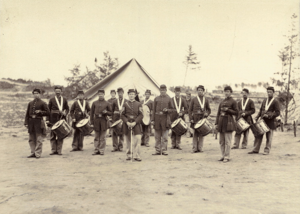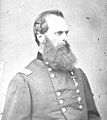Pennsylvania in the American Civil War facts for kids
During the American Civil War, the state of Pennsylvania was super important for the Union (the North). It gave a lot of soldiers, equipment, and strong leaders to the government. Pennsylvania sent over 360,000 soldiers to fight. It also made tons of cannons, small guns, and ammunition. The state even produced special armor for new ironclad ships and supplied a lot of food. For example, the Phoenixville Iron Company made more than 1,000 cannons! The Frankford Arsenal was a huge supply center.
Pennsylvania was also where the bloodiest battle of the war happened: the Battle of Gettysburg. Many people see this battle as a major turning point in the Civil War. Other smaller fights and raids also took place in Pennsylvania, like when Confederate soldiers burned much of Chambersburg, Pennsylvania. The industrial town of York, Pennsylvania, was the biggest Northern city taken over by the Confederate States Army during the war.
Many important Union leaders came from Pennsylvania. These included generals like George G. Meade (who won at Gettysburg) and Winfield S. Hancock. Admiral David D. Porter was a naval hero. Important political figures included Secretary of War Simon Cameron and the strong anti-slavery Radical Republican Thaddeus Stevens. A few Pennsylvanians even joined the Confederacy, like Generals John C. Pemberton and Josiah Gorgas.
Contents
Pennsylvania's Soldiers: How Many Joined?
More than 360,000 Pennsylvanians joined the Union Army. This was more soldiers than any other Northern state except New York. Pennsylvania quickly raised 215 infantry (foot soldier) regiments. It also formed many emergency militia groups. These militias were ready to defend against Confederate attacks in 1862 and 1863. Twenty-two cavalry (horseback soldier) regiments and many artillery (cannon) units also joined.
Most Pennsylvania soldiers fought in the Eastern Theater. This means they fought mainly in Virginia, Maryland, and Pennsylvania. Only about 10% served in other areas. The Pennsylvania Reserves were special. They were the only army division made up entirely of soldiers from one state. They fought in most of the big battles of the Army of the Potomac. The Philadelphia Brigade was also unique because all its regiments came from just one city.
One regiment, the "Corn Exchange Regiment", was even paid for by the Philadelphia Corn Exchange! The 47th Pennsylvania Infantry Regiment was the only one from Pennsylvania to fight in the 1864 Red River Campaign in Louisiana. Some of its soldiers were even POWs at Camp Ford, a large Confederate prison. Later, the 47th fought in the Shenandoah Valley Campaign in Virginia. This included battles like Berryville and Cedar Creek.
Training Camps and Heroes
Most new Pennsylvania regiments trained at Camp Curtin near Harrisburg. Thousands of soldiers from other states also trained there. Other important training spots were near Pittsburgh, Easton, and Philadelphia. Over 100 Pennsylvania soldiers won the Medal of Honor. This is the highest award for bravery in the military.
Pennsylvania also led the way in sending Black soldiers to the Union Army. About 8,612 Black soldiers from Pennsylvania joined. They formed eleven regiments of U.S. Colored Troops. Most of these troops trained at Camp William Penn. This camp, north of Philadelphia, was the only one just for training Black soldiers. The 47th Pennsylvania Infantry even became integrated. This happened in 1862 when formerly enslaved Black men joined the regiment in South Carolina. More joined in 1864 during the Red River Campaign.
Key Leaders from Pennsylvania
Many important generals came from Pennsylvania. These included Winfield S. Hancock and John F. Reynolds. Even though he was born in Spain, George G. Meade lived in Pennsylvania for most of his life. He is buried in Philadelphia. Herman Haupt was another hero. He led the U.S. Military Railroad and changed how military supplies moved. Important naval leaders included Admiral David Dixon Porter and Rear Admiral John A. Dahlgren.
Pennsylvania's Factories: Fueling the War
Pennsylvania was a super important source of materials for the Union. It provided almost all of the "smokeless" anthracite coal for the military. It also supplied most of the other type of coal, bituminous coal. Nearly 80% of all the iron for the government came from Pennsylvania foundries. The state also produced huge amounts of flour, meat, food, clothes, and uniforms. The Cumberland Valley was a very fertile farming area. It sent vast amounts of food and grain to the Army.
Railroads were also vital for moving supplies and troops. The Baltimore & Ohio Railroad and the Pennsylvania Railroad were especially important. The Northern Central Railway connected Harrisburg to Baltimore, Maryland, and Washington, D.C..
Making Weapons and Supplies
The Bethlehem Iron Works made railroad tracks and armor plating for the U.S. Navy's ships. The Phoenixville Iron Company in Chester County made the most wrought iron cannons for the Union army. At its busiest, it made fifty 3-inch cannons every week! Smaller factories made steel swords, rifles, pistols, tools, tents, and other items. This made Pennsylvania one of the most important places for government supplies.
The Philadelphia area was a huge help. The Frankford Arsenal was a key source of small-arms, ammunition, and artillery shells. The Philadelphia Navy Yard built ships and supplied sailors for the United States Navy. Most of the coal for Navy warships came from mines in northern Pennsylvania. Hospitals like Satterlee Hospital and Mower Hospital near Philadelphia were important places for treating wounded soldiers.
Pittsburgh's heavy industries also made many weapons and ammunition. The Fort Pitt Works near Pittsburgh made giant iron castings for huge howitzers and mortars. These were some of the biggest guns in the world. This factory made 1,193 guns, which was 15% of all U.S. artillery made during the war. It also made almost 200,000 artillery shells. Other Pittsburgh factories, like Singer, Nimick, and Co., made more than 300,000 artillery shells. Overall, Pittsburgh industries made 10% of all artillery shells for the U.S. Army.
The U.S. Allegheny Arsenal was the main place for making military gear. This included saddles and other equipment for cavalry. The Allegheny Arsenal also made up to 40,000 bullets and cartridges every day. This supplied 5% to 10% of the Army's yearly small arms ammunition needs.
Pittsburgh also helped build ships. Five Ellet-class ram ships were changed from civilian boats there. Four ironclad ships were built from scratch: the USS Manayunk, Marietta, Sandusky, and Umpqua. Pittsburgh factories also supplied the armor for many ironclads built in New York and Philadelphia.
Battles and Raids in Pennsylvania
Because Pennsylvania was so important for supplies and close to the Mason–Dixon line (the border between North and South), it was attacked several times by the Confederate States Army. Confederate cavalry (horseback soldiers) led by J.E.B. Stuart raided in 1862 and 1863. John Imboden raided in 1863, and John McCausland raided in 1864. McCausland's soldiers even burned the city of Chambersburg. People in Pittsburgh were worried in 1863 when Morgan's Raid got close to Pennsylvania, but it was stopped in Ohio.
The most famous battle in Pennsylvania was the Battle of Gettysburg, near Gettysburg. Many historians believe this battle was a major turning point in the Civil War. Soldiers who died in this battle are buried at Gettysburg National Cemetery. This is also where Abraham Lincoln gave his famous Gettysburg Address. Several smaller battles were also fought in Pennsylvania during the Gettysburg Campaign. These included the Battle of Hanover, Battle of Carlisle, and Battle of Fairfield. The city of York, Pennsylvania became the largest Northern city to be taken over by Confederate troops. This happened when Jubal A. Early's division took control in June 1863 and demanded money.
Pennsylvania's Role in War Politics
In the 1860 Presidential Election, Pennsylvania voted for Abraham Lincoln. He received 56.3% of the votes in the state.
During the war, Republicans were in charge of Pennsylvania politics. This was thanks to Governor Andrew G. Curtin. He was a strong supporter of President Lincoln. In the very southern part of the state, there were some Copperheads. These were people who wanted peace with the Confederacy, even if it meant letting slavery continue. They were mainly in Fulton, Adams, and York counties.
On the national level, Simon Cameron was Secretary of War early in Lincoln's presidency. Congressman Thaddeus Stevens was a leading voice for the Radical Republicans in Washington. He strongly supported the war and had harsh views on how to rebuild the South after the war (called Reconstruction). Confederate soldiers led by Jubal A. Early burned Stevens' Caledonia Iron Works. This was because Stevens strongly supported destroying things in the South to hurt the Confederacy.
One Pennsylvania soldier wrote about meeting an enslaved woman. He was shocked by her story of slavery. He said, "I thought I had hated slavery as much as possible before I came here, but here, where I can see some of its workings, I am more than ever convinced of the cruelty and inhumanity of the system."
After the Battle of Antietam in 1862, thirteen Union governors met in Altoona, Pennsylvania. Governor Andrew G. Curtin organized this meeting. They talked about war plans, how many troops were needed, and the Union's goals. The governors supported the war effort and shared their thoughts on the Emancipation Proclamation. They then went to Washington, D.C., to meet Abraham Lincoln. A few weeks later, Lincoln removed General George B. McClellan from leading the Army of the Potomac. The governors had expressed their unhappiness with McClellan. Lincoln then issued the Emancipation Proclamation.
By late 1864, most Pennsylvania voters supported President Lincoln again. In the Presidential Election, Lincoln received 51.6% of the votes in Pennsylvania.
Preserving History: Remembering the War
Even while the war was still going on, people in Gettysburg started working to save parts of the battlefield. They wanted to honor the soldiers who fought there. Pennsylvania also worked to record the history of every regiment and unit from the state. In 1869, the official state historian, Samuel Penniman Bates, wrote a huge five-volume book called History of the Pennsylvania Volunteers, 1861-1865. This book is still a key reference for the state's military history.
The State Archives in Harrisburg keeps military records. This includes records of emergency militias and volunteer regiments. It also has records of damage claims from people whose property was destroyed during the Gettysburg Campaign. The Pennsylvania Capitol Preservation Committee takes care of nearly 400 of Pennsylvania's historic Civil War battle flags. The State Museum of Pennsylvania has a large collection of Civil War items. It also has a massive painting of the Battle of Gettysburg by Peter Rothermel.
The National Civil War Museum in Harrisburg is one of the best places to learn about the Civil War. The Visitors Center at the Gettysburg Battlefield has thousands of items. This includes the largest collection of old Civil War weapons in Pennsylvania. Other Civil War museums are found across the state. There are also county archives and hundreds of memorials and historical markers. A huge state-sponsored monument at the Gettysburg National Military Park honors Pennsylvania's soldiers and leaders.
Images for kids
-
Sec. of War
Simon Cameron -
Maj. Gen.
Darius N. Couch -
Maj. Gen.
Samuel W. Crawford -
Maj. Gen.
William B. Franklin -
Maj. Gen.
John W. Geary -
Maj. Gen.
David McM. Gregg -
Maj. Gen.
Winfield S. Hancock -
Maj. Gen.
John F. Hartranft -
Maj. Gen.
Herman Haupt -
Maj. Gen.
George B. McClellan -
Maj. Gen.
George G. Meade -
Qtrmaster. Gen.
Montgomery C. Meigs -
Adm.
David Dixon Porter -
Maj. Gen.
John F. Reynolds -
Rep.
Thaddeus Stevens




















